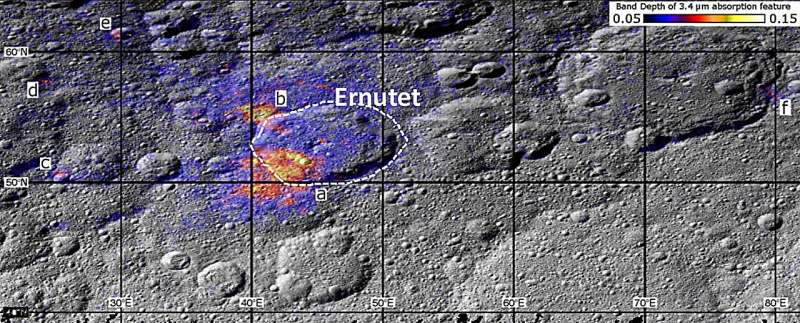
Six years ago, NASA’s Dawn mission communicated with Earth for the last time, ending its exploration of Ceres and Vesta, the two largest bodies in the asteroid belt. Since then, Ceres —a water-rich dwarf planet showing signs of geological activity— has been at the center of intense debates about its origin and evolution.
Now, a study led by IAA-CSIC, using Dawn data and an innovative methodology, has identified 11 new regions suggesting the existence of an internal reservoir of organic materials in the dwarf planet. The results, published in The Planetary Science Journal, provide critical insights into the potential nature of this celestial body.
In 2017, the Dawn spacecraft detected organic compounds near the Ernutet crater in Ceres’ northern hemisphere, sparking discussions about their origin. One leading hypothesis proposed an exogenous origin, suggesting these materials were delivered by recent impacts of organic-rich comets or asteroids.
This new research, however, focuses on a second possibility: that the organic material formed within Ceres and has been stored in a reservoir shielded from solar radiation.
“The significance of this discovery lies in the fact that, if these are endogenous materials, it would confirm the existence of internal energy sources that could support biological processes,” explains Juan Luis Rizos, a researcher at the Instituto de Astrofísica de Andalucía (IAA-CSIC) and the lead author of the study.
A potential witness to the dawn of the solar system
With a diameter exceeding 930 kilometers, Ceres is the largest object in the main asteroid belt. This dwarf planet—which shares some characteristics with planets but doesn’t meet all the criteria for planetary classification—is recognized as the most water-rich body in the inner solar system after Earth, placing it among the ocean worlds with potential astrobiological significance.
Additionally, due to its physical and chemical properties, Ceres is linked to a type of meteorite rich in carbon compounds: carbonaceous chondrites. These meteorites are considered remnants of the material that formed the solar system approximately 4.6 billion years ago.
“Ceres will play a key role in future space exploration. Its water, present as ice and possibly as liquid beneath the surface, makes it an intriguing location for resource exploration,” says Rizos (IAA-CSIC). “In the context of space colonization, Ceres could serve as a stopover or resource base for future missions to Mars or beyond.”
The ideal combination of high-quality resolutions
To explore the nature of these organic compounds, the study employed a novel approach, allowing for the detailed examination of Ceres’ surface and the analysis of the distribution of organic materials at the highest possible resolution.
First, the team applied a Spectral Mixture Analysis (SMA) method—a technique used to interpret complex spectral data—to characterize the compounds in the Ernutet crater.
Discover the latest in science, tech, and space with over 100,000 subscribers who rely on Phys.org for daily insights.
Sign up for our free newsletter and get updates on breakthroughs,
innovations, and research that matter—daily or weekly.
Using these results, they systematically scanned the rest of Ceres’ surface with high spatial resolution images from the Dawn spacecraft’s Framing Camera 2 (FC2). This instrument provided high-resolution spatial images but low spectral resolution. This approach led to the identification of eleven new regions with characteristics suggesting the presence of organic compounds.
Most of these areas are near the equatorial region of Ernutet, where they have been more exposed to solar radiation than the organic materials previously identified in the crater. Prolonged exposure to solar radiation and the solar wind likely explains the weaker signals detected, as these factors degrade the spectral features of organic materials over time.
Next, the researchers conducted an in-depth spectral analysis of the candidate regions using the Dawn spacecraft’s VIR imaging spectrometer, which offers high spectral resolution, though at lower spatial resolution than the FC2 camera. The combination of data from both instruments was crucial for this discovery.
Among the candidates, a region between the Urvara and Yalode basins stood out with the strongest evidence for organic materials. In this area, the organic compounds are distributed within a geological unit formed by the ejection of material during the impacts that created these basins.
“These impacts were the most violent Ceres has experienced, so the material must originate from deeper regions than the material ejected from other basins or craters,” clarifies Rizos (IAA-CSIC). “If the presence of organics is confirmed, their origin leaves little doubt that these compounds are endogenous materials.”
These findings are supported by a related study by Italian collaborators who also participated in this work. Through laboratory experiments, the team demonstrated that organic compounds degrade more rapidly under solar radiation than previously estimated.
Given the detected quantities and observed degradation levels, the study suggests that organic material must exist in large quantities beneath Ceres’ surface.
“The idea of an organic reservoir in such a remote and seemingly inert location like Ceres raises the possibility that similar conditions could exist on other solar system bodies. Without a doubt, Ceres will be revisited by new probes in the near future, and our research will be key in defining the observational strategy for these missions,” concludes Rizos.
More information:
J. L. Rizos et al, New Candidates for Organic-rich Regions on Ceres, The Planetary Science Journal (2024). DOI: 10.3847/PSJ/ad86ba
Maria Cristina De Sanctis et al, Recent replenishment of aliphatic organics on Ceres from a large subsurface reservoir, Science Advances (2024). DOI: 10.1126/sciadv.adp3664
Journal information:
The Planetary Science Journal
,
Science Advances
Provided by
Instituto de Astrofísica de Andalucía
New evidence of organic material identified on Ceres, the inner solar system’s most water-rich object after Earth (2024, December 4)
retrieved 4 December 2024
from https://phys.org/news/2024-12-evidence-material-ceres-solar-rich.html
part may be reproduced without the written permission. The content is provided for information purposes only.